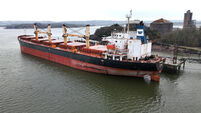UN agency warns of ‘heroin tsunami’ in Europe
The UN Office on Drugs (UNODC) said a record opium harvest in Afghanistan means there is twice the amount of heroin in Europe than would normally be used.
Gardaí have previously warned of a rise in the amount of heroin coming into this country as reflected by a sharp jump in the quantity being seized.
The seizure last week of 25kg of heroin in Dublin brought the total heroin haul so far in 2008 to 96kg. This compares to 146kg in 2007, which was the largest annual haul of heroin.
The UNODC’s World Drug Report 2008 said the continuing rise in opium cultivation last year was being mirrored by a hike in coca cultivation, which threatened to accelerate the production of cocaine.
“This report provides evidence of a surge in the supply of illicit drugs in 2007,” said UNODC executive director Antonio Maria Costa. “Afghanistan had a record opium harvest, and world opium production almost doubled between 2005 and 2007.”
The report said opium cultivation increased by 17%, from 165,000 hectares in 2006 to 193,000ha in 2007. The potential opium production translated as 6,100 metric tonnes in 2006 and 8,200mt in 2007 — a rise of 34%.
Mr Costa said this was twice as much supply than demand, but said it wasn’t clear where the extra supply was going.
He said a “heroin tsunami” was starting to “wash up on the shores of Europe”, which was already seeing a fall in heroin prices on the street. The report said there was a rise of 16% in coca cultivation in the main producing countries of Columbia, Bolivia and Peru, although it noted that potential production volumes so far remained unchanged.
It said while increases in Europe had fuelled the overall increase in cocaine consumption over the last decade, there were signs that “stabilisation may be on the horizon”.
The report said there were two worrying trends in cannabis. It said Afghanistan had become a significant producer and indoor cultivation was producing more potent strains of cannabis herb. “The past few World Drug Reports have stated that the world drug problem is being contained in the sense that it had stabilised,” said Mr Costa. “This year’s report shows that containment is under threat.
“Containment should not be seen as an end in itself. Real success will only come when supply and demand actually go down (rather than level off)...
“The current upsurge in supply together with the development of new trafficking routes (mostly through Africa) could eventually strengthen demand where it already exists (mostly in developed countries) and create new markets for some of the world’s deadliest substances (mostly in developing countries).”














